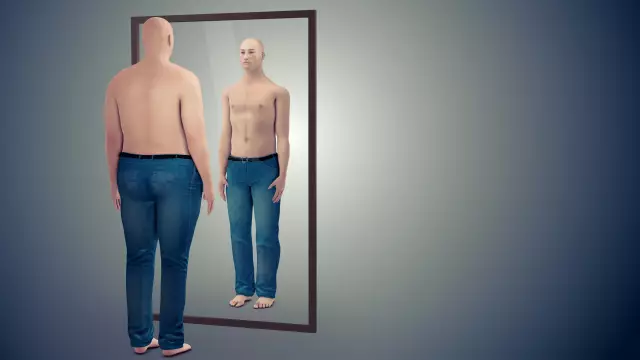- Author Rachel Wainwright [email protected].
- Public 2023-12-15 07:39.
- Last modified 2025-11-02 20:14.
Stem stroke - what is it?
The content of the article:
- Types of strokes
- The reasons
- Brain stem stroke symptoms
- Treatment tactics
- The prognosis of recovery in stem stroke
- Video
Stem stroke is an acute pathological condition in which blood circulation in the brain stem is impaired. Stroke can also affect the brain and spinal cord (called a spinal stroke). As a result, oxygen starvation of neurons and their death occurs, which leads to the loss of brain functions controlled by this area.
Why does a stem stroke occur, what is it and is recovery possible for patients who have had an attack?

The brain stem connects the spinal cord with the brain, it is one of the most important structures of the nervous system
The brain stem is an important part of the nervous system. It is located at the base of the skull, through which passages connect the spinal cord and the cerebral cortex. The brain stem includes the medulla oblongata, the pons varoli and the midbrain, contains the cranial nerves and their nuclei, vasomotor and respiratory nerve centers. Thus, the brain stem provides interaction between the structures of the central nervous system, transmits commands from the brain, carries out reflex reactions, chewing, swallowing, regulates muscle tone, is responsible for respiration, blood circulation, autonomic reactions, thermoregulation, balance, and participates in the functioning of the organs of hearing and vision.
Types of strokes
Depending on the etiology, a stroke can be ischemic and hemorrhagic.
Ischemic stem stroke occurs as a result of blockage or compression of the vessels carrying blood to the brain, a torn off thrombus, a blood clot, in rare cases - fat droplets or air bubbles. Compression of the vessel can occur due to a tumor or scar formed after injury. Ischemic stroke develops much more often than hemorrhagic, and has a more favorable prognosis.
Hemorrhagic stroke develops as a result of rupture of a vessel, in which not only the nutrition of a certain part of the brain is disturbed, but the blood soaks and squeezes the brain tissue, forming a hematoma. With hemorrhagic stem stroke, the nerve centers of life support are damaged in the brain stem.
Due to the lack of oxygen, the nerve cells of the stem brain cease to perform their functions, as a result of which the coordinated work of all internal organs stops.
The reasons
Among the pathologies leading to a brain stem stroke, the following are most common:
- arterial hypertension - causes irreversible changes in the arteries and arterioles of the brain, the walls of the vessels become brittle, sooner or later they may rupture with hemorrhage;
- atherosclerosis - observed in most elderly people, leads to the appearance of cholesterol plaques in the arteries that feed the brain, as a result, the plaque clogs the vessel;
- aneurysms and vascular malformations - cause strokes in young patients without concomitant pathology or in combination with it;
- diabetes mellitus and other metabolic disorders affecting blood vessels;
- rheumatic diseases;
- heart disease - valve pathology and congenital defects;
- blood clotting disorders, including when taking thrombolytic drugs prescribed to a cardiac patient.
Increases the risk of stroke, alcohol and tobacco abuse, improper and irregular nutrition, excess weight, sedentary lifestyle, stress, overwork.
Brain stem stroke symptoms
The deterioration of the condition occurs suddenly, the following symptoms are observed:
- articulation and speech clarity are impaired (blurred speech);
- there is a lack of coordination;
- dizziness occurs, gait becomes unsteady;
- facial skin may turn pale or red;
- blood pressure rises, pulse quickens;
- the temperature decreases and then rises;
- sweating develops.
In the future, respiratory and circulatory disorders may join these symptoms. Breathing with a stroke becomes hoarse, quickened, shallow, with difficulty breathing in and out. The patient may lose consciousness.

At the first signs of a stroke, the patient needs to call an ambulance, since treatment is most effective in the first 3 hours
In some patients, a brain stem stroke is accompanied by the development of locked-in syndrome. In this condition, as a result of a violation of the transmission of impulses from the brain to the muscles of the body, paralysis of the limbs and a complete loss of motor function occur. The patient retains consciousness, he is able to understand and evaluate what is happening. It is possible for such a patient to actively participate in their rehabilitation.
Even minor symptoms of a stroke cannot be ignored, as a stroke can lead to irreversible consequences. When the first signs appear, it is necessary to immediately seek emergency medical help, and before the arrival of doctors, ensure the patient is at rest in a supine position and an influx of fresh air.
Treatment tactics
The prognosis for stroke directly depends on the time of initiation of treatment. A patient with acute cerebrovascular accident must be taken to the neurosurgical department of the hospital as soon as possible. How long does the treatment take, what kind of therapy is carried out in the hospital, and what is the likelihood that the patient will recover from a stroke?
In the first few hours after a hemorrhagic stroke, surgery may be necessary to stop bleeding.
If necessary, platelet mass is injected into the lesion site. This method is especially effective in the first few hours after the onset of the disease. Studies show that patients who received such therapy improved the trophism of ischemic tissue faster, restored motor functions faster and had a lower risk of death. Among other things, platelet infusion can reduce the risk of late complications.
In the first 1-3 days after a stroke, treatment is carried out in a hospital setting. After stabilization of the patient's condition, diagnostics are performed to determine the degree of damage to the stem structures. In accordance with the test results, treatment is prescribed, which pursues the following goals:
- restore and maintain vital body functions;
- restore physiological blood supply to areas of the brain affected by stroke;
- relieve swelling and inflammation of damaged brain tissue;
- maintain the rheological properties of blood and normal clotting;
- support the work of the cardiovascular system.
Also, specific treatment is prescribed, which depends on the location and size of the lesion.
After discharge from the hospital, home treatment continues for several weeks, including drug therapy, massage and exercise. This is followed by a rehabilitation period, which can take several months.
The prognosis of recovery in stem stroke
2/3 of cases of brain stem stroke are fatal, the most dangerous period in this regard is the first two days. This is due to a violation of basic vital functions.
In many respects, the prognosis depends on the timeliness of the medical care provided, the most effective treatment is in the first three hours after the attack. The prognosis depends on the patient's age: in old people, the body's regenerative abilities are reduced.

Post-stroke rehabilitation is carried out for several months
The possibility of successful rehabilitation depends on which functional centers of the brain stem were affected and which functions were affected:
- breathing - a violation occurs in case of damage to the respiratory center of the brain stem. The patient cannot breathe on his own and in most cases becomes dependent on an artificial respiration apparatus. However, if the respiratory brain center is not completely destroyed, recovery is possible;
- swallowing - one of the main signs of a brainstem infarction is dysphagia, or swallowing disorder. This disorder occurs in most people who have had a brain stem stroke. Dysphagia threatens with life-threatening consequences: aspiration pneumonia, exhaustion and dehydration. The prognosis for the recovery of patients with dysphagia is uncertain, continuous drug therapy is required;
- coordination of movements - early signs of stroke are dizziness, shaky gait, and loss of balance. Usually, these signs disappear during treatment and rehabilitation. The prognosis for the restoration of this function is generally favorable;
- limb motility - with a stroke, the control of movements of the arms and legs is impaired, often on the same side. A favorable prognosis for such a disorder can be made only in the first 2-3 months after a stroke, then the dynamics of restoration of motor functions decreases. After 6 months, complete and partial recovery of movement control is extremely rare;
- thermoregulation - a stroke may be accompanied by a violation of thermoregulation, which indicates a serious condition of the patient. A persistent rise in temperature above the threshold values indicates damage to the thermoregulatory center and aggravates ischemic damage to brain tissue. A decrease in body temperature for every degree doubles the likelihood of a favorable outcome;
- vision - if the oculomotor center, which is located in the brain trunk, is damaged, there is a violation of eye movements. The chances of restoration of visual functions with proper therapy are quite high.
Video
We offer for viewing a video on the topic of the article.

Anna Kozlova Medical journalist About the author
Education: Rostov State Medical University, specialty "General Medicine".
Found a mistake in the text? Select it and press Ctrl + Enter.






